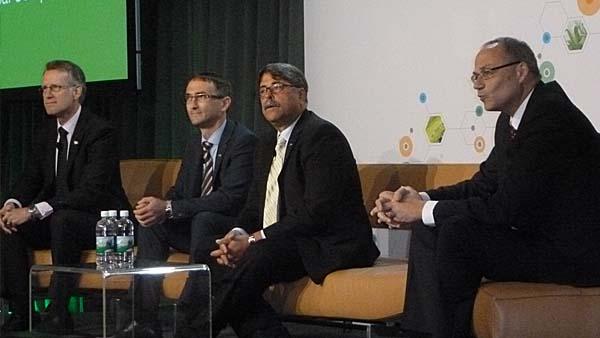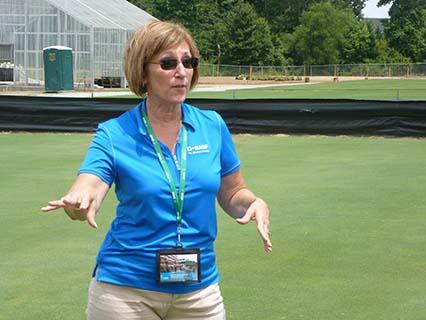 Sustainability isn't a buzzword or catchphrase at BASF. Instead, it's a philosophy that extends throughout all of the multinational corporation's five business segments at nearly 700 production sites in 80-plus countries around the world.
Sustainability isn't a buzzword or catchphrase at BASF. Instead, it's a philosophy that extends throughout all of the multinational corporation's five business segments at nearly 700 production sites in 80-plus countries around the world.
"We create chemistries for a sustainable future. This is totally different from 'we sell chemicals,' " said Andreas Kreimeyer, BASF's research executive director and a member of the corporation's board of directors.
"Creating chemistry means we combine chemicals. It's about how we use them, how to make our customers more successful using them, offering technical service and helping our customers design exclusive programs."
Nowhere within that corporate structure is this philosophy more evident than in BASF's Agricultural Solutions division, or more specifically, within the unit's crop protection segment.
Every two years, members of the upper management team from BASF's headquarters in Ludwigshafen, Germany, as well as those who oversee its crop protection business in North America convene at the BASF North American Agricultural Solutions Media Summit to discuss the crop protection challenges facing the world and BASF's efforts to confront them.
"We are trying to move from a technology-driven and product-oriented organization to a solutions-oriented organization," said Markus Heldt, president of the company's crop protection unit, during this year's summit held in Durham, North Carolina.
For BASF, that means focusing on innovation and research and development for new products and ideas, dialing in on customer needs and bringing those innovations to customers faster, Heldt said.
According to Kreimeyer, BASF spends $1.8 billion annually just in R&D and employs 10,000 people in that field worldwide. About 37 percent, or nearly $2 million per day, of that is devoted to research in crop protection, Heldt said.
Admittedly, most of the bi-annual program is devoted to the corporation's efforts to meet the food-production needs of a growing world population, but that focus on sustainability translates to the company's turf and ornamental business as well. In fact, many of the products that eventually emerge on the turf and ornamental side of the industry were born in agriculture, where the bulk of the research funding lies.
 Two examples of the journey toward sustainability in the turf market are the release of two new products that provide preventive and curative control of a host of fungal diseases.
Two examples of the journey toward sustainability in the turf market are the release of two new products that provide preventive and curative control of a host of fungal diseases.
Xzemplar, with the active ingredient fluxapyroxad, is a succinate dehydrogenase inhibitor fungicide that works by blocking fungi respiration and disrupting the energy supply, which prevents further growth of fungal cells.
Lexicon Intrinsic contains both fluxapyroxad and pyraclostrobin, the ingredient common to all products in BASF's Intrinsic portfolio. The U.S. Environmental Protection Agency granted label registration to both products in January.
"When you bring innovation to market, you have to be able to demonstrate an increase in value to the end user," said Jon Sweat, director of BASF's specialty products division. 'We have to demonstrate that using Lexicon means fewer trips than a superintendent would make with something else, or that it's more effective at a lower rate than other products.
"We are trying to look at it holistically. We are trying with active ingredients and inputs to make it for superintendents to be able to look at their constituents and say 'I am running a more sustainable operation than I was five years ago.' "
Fluxapyroxad, now branded as Xemium, is a chemistry in the carboxamide family, and exhibits enhanced systemic activity that BASF technical specialist Kathie Kalmowitz, Ph.D., says extends its residual properties, thus increasing the plant's ability to fight stress and resulting in longer, more prolific root growth and curative activity against disease.
During a Summit field trip to BASF's 130-acre research farm in Holly Springs, North Carolina, Kalmowitz showed the efficacy of each product on a Crenshaw creeping bentgrass plot subjected to abnormally hot summerlike conditions in late spring. Plots treated with Lexicon and Xzemplar were disease free, while the untreated control plot was pocked with dollar spot lesions.
"That means turf can go through a day like today, or just a normal day, and it means we have consistent growth patterns and we're not losing roots through these stress events," Kalmowitz said.
"First and foremost, we have to be a fungicide. Our customers demand that of us."
Among the outside factors prompting BASF to take a solutions-based look at the future is projected world population growth. According to the U.S. Census Bureau, the world population is nearly 7.2 billion. The United Nations projects that number to swell to more than 8 billion in the next decade and reach 9.6 billion by 2050. Although population growth has slowed in developed nations, the challenges associated with that projected growth are underscored by the fact that the UN predicts populations in the 49 least developed countries will more than double in the next 35 years. The challenge facing companies like BASF is how farmers worldwide will be able to produce enough food to meet that demand and how they can get it to the table affordably.
To do that, BASF says it will lean on its three pillars of sustainability that include efficiency in economy, ecology and society.
That means minimizing economic risk for customers, developing products and solutions that ensure BASF and its customers are able to practice stewardship without compromising efficacy.
"We have to get closer to our customers and bring those innovations, new ideas and business concepts to our customers faster around the globe," Heldt said. "To achieve this, we have to be close to our customers, focus on their needs and better anticipate their needs."

